The items you carry with you every day are a reflection of your expectations for life. You expect to receive text messages, to get on the bus or drive your car, to unlock doors and use your debit card.
But what about when things don’t go the way you expect?
This is why we carry other stuff too- stuff like a pocket knife, a mini flashlight, maybe a multi tool. Just in case. Now consider all the times you have the potential to get locked out during the day: your car, a gym locker, your backyard tool shed, your own front door. With the number of locking doors surrounding us every day and our own human capacity for failure, not to mention the potential for accidents outside of our control, it’s surprising that more of us aren’t carrying a small lockpick set.
What’s in a Lockpick Set?
At a bare minimum, a useful lockpick set will include a rake, a pick, and a tension wrench.
Rake
While you can pick a lock pin-by-pin with just a hook or other pick, a rake is especially useful for beginners in emergencies. As evidenced by the name, this tool is literally raked along the pins to bump them up into their appropriate place.
Pick
There are a wide variety of picks- your set should have something like a half-diamond or a hook pick, meant to individually bump the pins into place. With practice you’ll be able to interpret the feedback you feel in your hand through the pick to tell you whether the pin is in place or not.
Tension Wrench
A tension wrench is necessary because it maintains tension on the lock, which is what enables you to set the pins and turn the lock once you’ve picked it successfully. Without a tension wrench, picking a lock is impossible.
Why do I Need a Lockpick Set if I’m not a Locksmith or a Criminal?
Lockpicks are not just for locksmiths and criminals. You’ll want to check the laws in your region before you make a purchase, but in most cases it’s perfectly legal for you to own the means to open any lock that you own in an emergency when you don’t have a key. This is a perfectly reasonable right that has much less to do with insidious intent than it does wishing to be prepared for emergency situations.
They Give You Peace of Mind
Carrying a set of lock picks gives you peace of mind that if you need it, you’ll have a backup plan in place. It also makes you available to help others in need at a moment’s notice. Being prepared is far preferable over helplessness.
They’re Easy to Carry
Some lockpick sets are easy to carry on your person every day without a second thought. So bulk or inconvenience becomes a non-issue.
What if I Don’t Know How to Pick Locks?
Lockpicking is a skill worth learning, especially if you’re interested in being prepared for any emergency in an urban environment. Honing the skill can take a lifetime, but there are tons of resources available online to get you started. Check out our list of the top 20 resources for lockpicking beginners.
We also created a brief tutorial to get you started picking locks. Read through it, understand the various parts at play, and then get your hands on a set and start building muscle memory.
How to Make a Lockpick Set Part of Your EDC
Most lockpick sets are bulky, too big, or otherwise hard to carry on your person, with more picks than you’ll ever need for a simple pin tumbler lock. The key to success is to find a lockpick set that doesn’t take up much extra space and includes only what you’ll need in an emergency.
To that end, the best way to incorporate something seamlessly into your EDC is to include it as part of something you already carry- in your wallet or on your keyring or belt loop.
When we discovered that there weren’t any lockpick sets on the market that were small and light enough to carry every day, we made one.
The PicoPick is TIHK's answer to bulky lockpick sets that are hard to comfortably carry on your person. The matte black case is inconspicuous and easy to forget about on your keychain... until you need it.
The smallest lock pick set on the market, the PicoPick is just over 2 inches long, under half an inch wide and a quarter of an inch thick. Don't let the unassuming size fool you... it has everything you need to pick most tumbler locks in an emergency situation.
In addition to a w-rake and half-diamond, the PicoPick set includes a removable tensioner, all stainless steel.
Over on SOFREP there's a new article up on how to pick handcuffs with nothing but a hairpin. It's a really helpful tutorial with step-by-step photos showing how a simple bobby pin can be used in a pinch to unlock a pair of handcuffs. He also explains the easier method of shimming, which is a really useful skill to have as well. The caveat is that a shim cannot be used on double-locked handcuffs. Double-locked cuffs are very common now, so you want to be sure that you have practiced a few methods of escaping them as well.
This is incredibly useful information to know, and important to practice if you are in law enforcement, security, or you travel regularly, especially to unstable countries or places where you don't speak the language. We created a similar tutorial with illustrations- check it out here.
There is no telling when handcuffs could be unlawfully used against you. Whether they're your own cuffs being used against you by a criminal, or an unlawful incident with corrupt police in a foreign country, it pays to have the knowledge and skill that will enable you to escape from unlawful restraint.
Being truly prepared for anything means having a Plan A, a Plan B, and preferably a Plan C as well. Flexibility and quick thinking under stressful circumstances will help you escape hairy situations with your life, and maybe even dignity, intact. So what do you do if your trusty hair pin slips out of your pocket? It would pay to have a tiny, inconspicuous handcuff key on your person as well. Not only are they easier to master than a bobby pin or shim, but if you know what you are doing they will buy you precious seconds as well. Check them out here and get prepared!
Shop Urban Survival Gear
If you’re ready to take the plunge into lock picking but are unsure of how to start, rest assured that you don’t need a huge arsenal of weirdly shaped picks to get started. For picking a simple pin tumbler lock, you only need the following items:
Tension Wrench
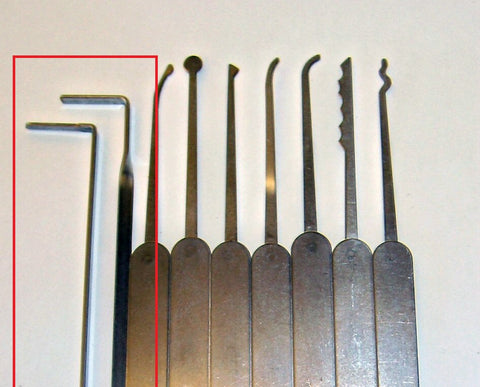
A tension wrench is a necessary component because it maintains tension on the lock, which is what enables you to set the pins and turn the lock once you’ve picked it successfully. Without a tension wrench, picking a lock is impossible.
Rake

While you can pick a lock pin-by-pin (called single pin picking or SPP) with just a hook or other pick, a rake is especially useful for beginners. It is also possible to pick a lock entire with just a rake and a tension wrench, but this often requires luck more than anything else. It’s not wise to rely on luck, so pack a rake in your kit but also be sure to include the final item...
Hook Pick
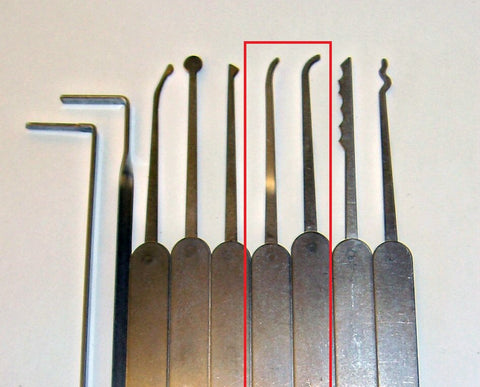
A hook pick is a very simple lock pick in (surprise!) the shape of a small hook. It can be used for careful single-pin picking or as a sort of simple rake.
Armed with some knowledge of the anatomy of a pin tumbler lock and how they function as well as these three tools and a lot of patience, you can successfully pick your first lock. The tension wrench maintains tension on the lock for the entire time you are picking, the rake can be used to try your luck at scrubbing the lock (setting as many pins as you can by chance), then the hook pick can be used to complete the picking process on any pins that didn’t set with scrubbing. There are many other shapes and kinds of lock picks available that are useful for different styles and methods of lock picking, but these initial three tools will carry you far until you’re ready to advance your lock picking skills.
Lock picking is a practice that requires patience. Once you’ve mastered the fundamentals, more advanced lock picking will naturally come more easily. The challenge lies in the initial mastery. In order to develop proficiency with lock picking you’ll need to spend a lot of time practicing. Lock picking is all about paying very careful attention to minute tactile feedback, and you’ll need to develop new muscle memory in your hands to get really good at it.
That being said, lock picking is not always inherently difficult. The basics of lock picking are fairly simple, and a thorough understanding of the inner mechanism of a traditional pin tumbler lock will be of tremendous help to you.
Common lock picking challenges
- Maintaining Tension- One of the challenges inherent in lock picking is in maintaining tension on the wrench with one hand for the entirety of the time that you are scrubbing or picking the lock with your other hand. Releasing tension at any time will force you to start from the beginning.
- Recognizing Tactile Feedback- Another challenge is recognizing which pins still have yet to be set, and which is the next binder pin (the least springy), all without the aid of your eyes. Since, with the exception of clear trainer locks, the mechanism of a lock is within a closed metal housing, you’ll be relying entirely on touch to give you information about tiny and delicate parts. This requires the cultivation of patience and sensitivity.
- Recognizing Lock Types- The difficulty level of picking a given lock will vary depending on the lock type. Recognizing what kind of lock mechanism lies within and knowing which tools and techniques are necessary for the job are skills that will grow with time as you practice and experiment.
Don’t let the idea of lock-picking intimidate you! Like any other skill, it takes practice and patience. But unlike many other skills, not only could it get you back into your locked house or car… it could possibly save your life.
Although some locks can be incredibly tricky to pick, the fundamentals of picking a basic pin-tumbler lock are fairly simple. The key to success, and eventually speed, is practice. With the exception of clear trainer locks (which are a great investment as you are building your lock picking skills), you’re not going to be able to see what you’re doing when you pick a lock. You’ll have to rely solely on tactile feedback, so the key to training your hands is repetition.
1. Obtain Your Lock
First, there are two basic rules to picking locks with integrity. The first is that you must not pick a lock that is in use. The second rule is that you may only pick locks that belong to you, or for which you have been given express permission to pick from the owner of the lock. Following these rules will ensure that you don’t venture into the realm of illegal activity, and should you choose to join a locksport organization it will keep you in good standing.
These instructions are for picking a basic pin tumbler lock. As mentioned above, a clear practice lock is an excellent choice to allow you to get a visual of the lock components and what is going on inside the lock as it’s picked. Once you’ve obtained your lock, ensure that it is clean and free of dirt or cracks. Older, worn, or dirty locks will be harder to pick and shouldn’t be attempted by beginners.
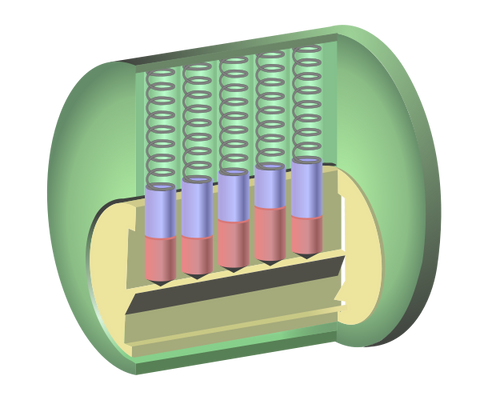
A pin tumbler lock with no key by Pbroks13 is licensed under CC BY-SA 3.0
2. Assemble Your Tools
Begin by assembling your basic lock picking tools. There are a wide variety of different picks available, but for beginning with a basic pin tumbler lock you will need only a tension wrench, a rake (or several rakes), and a hook pick.

“Lockpicks” by Ydam is licensed under CC BY-SA 3.0
3. Apply Tension
The application of tension to the lock plug mimics the tension of the key inside the lock. Tension is necessary to keep the driver pins in place once they’ve been moved above the shear line. Without the proper amount of tension, the pins will simply drop back down and prevent the plug from turning. To apply tension, insert the short end of the tension wrench into the bottom of the keyway with your non-dominant hand. Gently turn the tension wrench in the direction in which you would turn the key to open the lock. Turning the tension wrench in the wrong direction will prevent the lock from opening.
4. Rake the Pins
Begin with your rake tool. The rake is intended to quickly bump the pins up the shear line without the need for individual picking. To use the rake, insert it quickly into the keyway and scrub it back and forth with a motion not unlike toothbrushing. Continue to apply tension with the tension wrench the entire time. You will feel the plug give a bit as the pins align above the shear line, and if by chance you are able to move all the pins with only the rake, the lock will eventually turn completely.
There are many different shapes and styles of rakes available. If the first rake you try doesn’t catch all the pins, try a different one. Don’t forget to maintain tension in the keyway as you switch picks. If the tension is released before the lock is opened, you will have to start over.
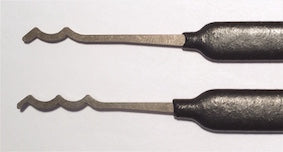
“Rake lock picks” by Willh26 is licensed under CC BY-SA 4.0
5. Pick Individual Pins
There may sometimes be stubborn pins that do not respond to raking. These will have to be picked individually. A common pick for this purpose is a hook pick. While maintaining tension with the wrench, insert the hook into the keyway and feel for pins that have yet to be engaged at the shear line. If there are multiple pins remaining, one will be less “springy” than the others. This is called the binding pin, and it should be engaged first. Using the hook, push the pin upwards until it clicks into place and remains above the shear line. Then feel with your pick for the next binding pin. Continue in this fashion until the remainder of the pins have been set. This requires you to pay close attention to the tactile feedback you’re receiving through the pick, since you won’t be able to see what’s going on.
6. Turn the Lock
As you continue to apply tension in the direction that the key unlocks, the plug will give a little more and more with each pin set. Once all the pins have been set, maintain tension and continue to turn the wrench in the correct direction until the lock opens.
Need a simple lock pick set? Check out our urban survival gear for light, compact options.
And why every survivalist, prepper, and regular person needs one.
What is a lock pick? Can you picture in your mind’s eye what a lock pick set looks like? What about a bump key, a shove knife, or a shim? Obviously we all understand the basic function of a lock pick without needing to be able to draw one from memory, but an understanding of the wide variety of available lock picks and how they work is an important first step to being more prepared for whatever life might throw your way.
Categories of Lock Picks
The easiest way to categorize lock picks is by the locks they are intended to open. A simple breakdown is:
- Lock picks for car locks (auto jigglers)
- Lock picks for standard pin tumbler locks (like those you find in the front door to your home)
- Bypass tools (shims, slim jims, shove knives)
- Tubular lock picks
Lock Picks for Unlocking Car Doors
The most common lock pick used for car doors is known as an auto jiggler. If you’ve ever had to call a locksmith because you locked your keys in your car, you may have seen them produce a large keyring of what look at a glance like regular car keys. Jigglers are also sometimes called “try out keys”, the purpose of which is simply to keep trying one in the lock until it opens. This requires less skill and practice than actually “picking” a lock with a lock pick set.
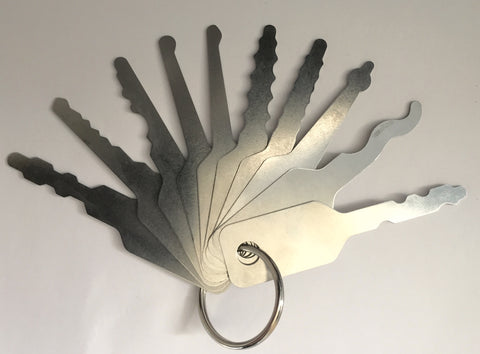
“Wafer Lock Try-Out Keys” by Willh26 is licensed under CC BY-SA 4.0
You Might Need One If…
...you lock yourself out of your car a lot. Or you are the single owner of your car and don’t share a set of keys with someone else. Or you don’t have the extra cash laying around to pay a locksmith to get you out of a tight spot. Some people choose to keep auto jigglers around so that if they ever come across a dog or a baby trapped in a hot car, they can take quick action and possibly save a life.
Pin Tumbler Lock Picks
Pin tumbler lock picks are probably the most common type of lock picking tools available, due to the popularity of the cylindrical pin tumbler lock. Most standard door locks use the pin tumbler design. Picking a pin tumbler lock requires two separate tools- a tension wrench, which is used to maintain tension on the lock and keep the lock pins from moving once they’ve been set in the correct position, and lock pick for moving and setting the pins. Some basic lock pick shapes include the rake, hook, ball, and diamond. Each of these types comes in many different sizes and variants, and will be effective on different types of locks.

“Lockpicks” by Ydam is licensed under CC BY-SA 3.0
Rake lock picks are a little different in function from hook, ball, and diamond picks. The purpose of a rake is to literally “rake” the pick along the pins, with the intention of bumping several pins up to the shear line at once. This is a quicker, if less precise and inelegant, method. It doesn’t always work.

“Rake lock picks” by Willh26 is licensed under CC BY-SA 4.0
You Might Need One If…
… you breathe air! A lock pick set and some basic knowledge is an incredibly valuable skill to have, not just for survival situations but for day-to-day matters. We’ve all locked ourselves out of the house at least once. Have you ever resorted to breaking your own window to get back in? Or what about that old locked briefcase that’s been in your garage for years without a key, or the mom down the street who’s frantic because her toddler just locked her out? Lock picks are not just for preppers and locksmiths.
Bypass Tools
A bypass tool is a tool that allows you to literally bypass a lock without picking it. The most well known bypass tools are probably shims and the humble credit card trick, made famous thanks to Hollywood (but be advised that attempting to get into a locked door with a credit card is likely to render your card bent out of shape and unusable). Any tool that allows you to get past a locked door without actively picking the lock would be considered a bypass tool. Depending on the tool and your expertise with it, you may or may not cause damage to the lock or door that could prevent it from being usable once you’ve gained access. A coat hanger or slim jim that is used to unlock a car door, for example, could potentially damage the lock inside the door not to mention delicate electronics, airbags, the window mechanism, etc.

This is why practice is so important: a working knowledge of the inside of the locking mechanism will allow you to understand what is happening whether you pick or bypass a lock, and reduce your chances of destroying the lock altogether.
You Might Need One If…
...you are a first responder of any kind. Bypass tools are quicker than lock picks for gaining entry when every second counts. They’re also useful for individuals in the repossession business. Aside from specialized careers, anyone would benefit from keeping a shim amongst their everyday carry, because you truly never know when one might come in handy.
Tubular Lock Picks
Tubular lock picks are special picks intended for, surprise, tubular locks.They are intended to be more resistant to picking than pin tumbler locks (they still contain pins, but they are arranged in a circle rather than in a line), although some people find them easier to pick with the help of a specialized tubular lock pick.
You Might Need One If…
...you own anything that contains a tubular lock. Tubular locks can be found on computers, gun safes, and vending machines, among other things.
If you are interested in lockpicking, you may from time to time see the disclaimer on a website that certain lock picking items will only be sold to “bona fide” locksmiths. The United States Postal Service, for example, considers lock picking tools non-mailable except when they are being shipped to a bona fide locksmith. The question then arises- what does “bona fide” even mean?
“Bona fide” is a Latin term that literally means “good faith”. In the context of law it essentially means “the real thing, without the intention of defrauding”. A bona fide locksmith is, therefore, a real locksmith. The implication here is that the locksmith in question is certified to the fullest extent required by their jurisdiction. You may quickly find that this is still not enough information, however. The term “bona fide locksmith” is hazy and less specific than it could be, because not every state requires a license to practice as a locksmith. There is a wide variety of voluntary professional certifications available, particularly through Associated Locksmiths of America (ALOA). (Voluntary professional certifications like those provided by ALOA are not required by law to practice as a locksmith; rather they work to establish credibility among customers and professional peers.)
The states that currently require licensing prior to operating as a locksmith are Alabama, California, Connecticut, Illinois, Louisiana, Nebraska, New Jersey, New York City, Nevada, North Carolina, Oklahoma, Oregon, Tennessee, Texas, and Virginia. Please do not consider this list exhaustive or authoritative, and do your own research before purchasing lock picking tools.
It is worth noting that most states allow possession of lock picking tools by anyone. The issue of being a “bona fide locksmith” most often comes into play when discussing the transfer of said tools using the United States Postal Service. If you buy the tools in person or without using USPS in most states, you are not required to provide proof that you are a bona fide locksmith. Similarly, most online stores will not require you to furnish proof. Some require you to check a box agreeing that you are a bona fide locksmith before they will ship to you for purposes of their own liability. We recommend telling the truth and paying close attention to whether you can legally be considered a “bona fide locksmith” in your state, but among the recreational locksmithing community it’s agreed that there is a lot of wiggle room in this area when it comes to ordering products online for your own personal, legal use.
For lock picking enthusiasts and survivalists alike, the legality of lock picks is a tricky subject. The good news is that in most of the United States and many countries around the world, the sale, transfer, and possession of lock picking tools is not illegal.
The Language of Legality
The language we use to discuss the legality of lock picking can be a breeding ground for misunderstanding, so let’s take a moment to clarify what we mean by some of the phrases we use.
Not illegal: There are no specific laws rendering illegal the sale, transfer, and/or possession of lock picking tools.
Prima facie evidence: The mere possession of lock picking tools is considered intent to break the law. It is illegal to possess lock picking tools in these states.
Must show intent: The mere possession of lock picking tools is legal; intent to break the law with the tools must be shown before possession of lock picking tools can be considered a crime.
A Note About Lock Picking
It is legal to pick any lock that you have received permission from the lock’s owner to pick. It is also legal to pick any lock that belongs to you. Picking locks that do not belong to you and/or that you do not have permission to pick is illegal.
Down to Brass Tacks
So let’s get down to it: where can and can’t you legally possess lock picking tools? The following states have laws that explicitly consider possession of lock picks prima facie evidence:
- Mississippi
- Nevada
- Ohio
- Tennessee
- Virginia
If you possess lock picking tools in any of these states, you can be charged with intent to commit a crime. Whether you actually do intend to break the law is irrelevant.
West Virginia, Pennsylvania, North Dakota and Indiana have no specific laws about possession of lock picking tools. Therefore in those states possession is not illegal. The remaining 41 states all have laws rendering the possession of lock picking tools legal, with the inclusion that intent to break the law must be shown before the possessor can be charged with a crime. The language here regarding “intent” is deliberately murky, to allow for a lot of wiggle room among a wide range of possible scenarios. Your local law enforcement and governing body will have the final say on what constitutes intent.
The best ways to avoid running into a snag with the law are:
- Only pick locks you are legally permitted to pick
- Educate yourself on the specifics of the laws in your state
- Abide by those laws
For links and further information please visit our Guidelines page.
The world of lock-picking is complex. For the novice hoping to jump in, figuring out where to begin can be a daunting task. Let us make it a bit easier for you with this handy and simple guide to the 6 most common lock picks! Among them are the two most popular tools that no lock picking enthusiast should ever be caught without.
First Things First: Get Thyself a Tension Wrench.
This one is so essential it's not even part of the actual list. If you hope to use any other other popular lock picks, a tension wrench is necessary. The tension wrench is inserted into the keyway like a normal key, and is used to apply torque and hold the pins in place once they’ve been properly aligned.
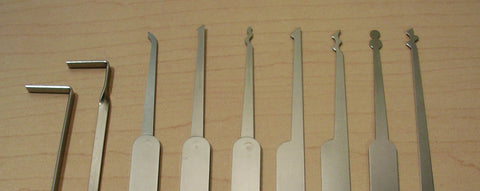
1. Half-Diamond (Triangle) Pick
Fourth from left in the above picture, the half diamond can be used on both wafer and disc locks, for working individual pins and for raking. The wide variety of ways you can use a triangle pick makes it the most versatile pick; it's a must-have in every lock picking kit. If your kit has nothing but a tension wrench and a triangle, you have an excellent start.
2. Hook Pick
The hook is the most basic of picks, used only for working individual pins.
3. Ball (Round) Pick
The ball (also known as a round) pick has a full- or half-circle shape at the end, and is commonly used on wafer locks.
4. Rake Pick
The rake pick, also often called the snake, is the most essential pick next to the half-diamond. Rake picks are literally raked across all pins to bounce them up until they reach the sheer line. Raking is also known as scrubbing, and is performed by inserting the rake into the keyway to push up all pins at once; the rake is then removed quickly while turning the plug with the tension wrench, causing some or all of the pins to land in the correct position.
5. Wafer Pick
A wafer pick is a special picks made specifically for wafer locks, although depending on who you ask within the lock-picking community, some will argue that a wafer lock can be picked with a regular pick and doesn't need one that's been specially designed. Wafer tumbler locks are generally considered easier to pick than pin tumbler locks because the keyhole is wider, and the wafers can't be pushed too far in like pins can.
6. Warded Pick
You may know a warded pick by it's more common name- the skeleton key. A warded pick is used for opening warded locks, which use a very simple design: a set of obstructions (wards) prevents the lock from opening without the correct key. A warded pick has been pared down to its most essential parts (thus the term skeleton). opening without the correct key.












